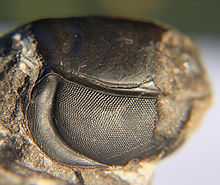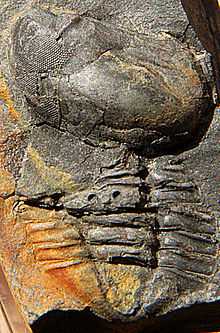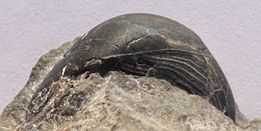Cyclopygidae
| Cyclopygidae Temporal range: Ordovician | |
|---|---|
 | |
| Cyclopygid cephalon, probably Symphysops stevaninae, 24mm, lateral view | |
| Scientific classification | |
| Kingdom: | Animalia |
| Phylum: | Arthropoda |
| Class: | Trilobita |
| Order: | Asaphida |
| Superfamily: | Cyclopygoidea |
| Family: | Cyclopygidae Raymond, 1925 |
| Subfamilies | |
And see text for assigned genera | |
The Cyclopygidae comprise a family of trilobites that is confined to the Ordovician. Cyclopygids had an extratropical distribution, and there is evidence that they lived in darker parts of the water column (around 175m deep). Cyclopygids are characterized by enlarged eyes, with a wide angle of view, both horizontal and vertical, reminiscent of the eyes of dragonflies. These typically touch the glabella directly on the side. Cyclopygids all lack genal spines, but Symphysops carries a forward directed frontal spine on the glabella. It is presumed that at least the members of the genus Pricyclopyge swam upside down and had bioluminescent organs on the third thorax segment. Cyclopygids had between 7 and 5 thorax segments, a wide and stout axis, and short side lobes (or pleurae).
Taxonomy

The following genera are assigned to the Cyclopygidae:
Subfamily Cyclopyginae
- Cyclopyge Hawle & Corda, 1847
- Delgamella Marek, 1961
- Gastropolus Whittard, 1966
- Heterocyclopyge Marek, 1961
- Microparia Hawle & Corda, 1847
- Novakella Whittard, 1952?
- Prospectatrix Fortey, 1981
- Sagavia Koroleva, 1967
Subfamily Ellipsotaphrinae
- EIlipsotaphrus Whittard, 1952
- Psilacella Whittard, 1952
Subfamily Pricyclopyginae
- Pricyclopyge Richter & Richter, 1954
- Circulocrania Fortey, 1987
- Emmrichops Marek, 1961
- Symphysops Raymond, 1925
Assignment unclear
- Aspidaeglina Holub, 1911
- Phylacops Cooper & Kindle, 1936
- Xenocyclopyge Lu, 1962
Genera previously assigned to the Cyclopygidae
- Girvanopyge (Remopleurididae)
Extinction
The extinction ending the Ordovician was one of the most radical for life to have experienced, and the trilobites were heavily affected. Those with pelagic or deep water benthic life styles (Olenidae, Agnostida) died out. Also the trilobites having planktonic larvae went extinct, and these include the Asaphida (Asaphidae, Nileidae, and Cyclopygidae), but not the Trinucleoidea. A reduction in diversity already occurred before this major extinction, but many families persisted into the Hirnantian, and it is possible that they would quickly have been restored to their former diversity. The crisis that started the Silurian must have exceptionally severe, and was associated with low oxygen levels in the oceans after an ice age.[1]
Description
Cyclopygidae have particularly large eyes with a wide angle view, also vertically, that occupy most of the free cheeks, and the fixed cheeks absent or reduced to a very narrow strip at the sides of the glabella, and a zone between the both eyes. In the earliest cyclopygids (Prospectatrix) the eyes are less enlarged,[2] but in some later taxa, eyes are so big they have even fused. The most backward lobe of the glabella (the occipital ring) cannot be identified, except in the Ellipsotaphrinae subfamily. Further furrows crossing the glabella may be absent or are reduced to pairs of slight depressions. Genal spines are lacking. Cyclopygids have between 5 and 7 thorax segments. The pleurae become successively wider further back, making the thorax widest across the last segment.[1]
Eyes

In pelagic trilobites, such as the Telephinidae (Proetida), and the Cyclopygidae, as in many extant pelagic crustaceans, the eyes are particularly large and have very wide angles of view, both horizontal and vertical. This is in stark contrast to contemporary benthic trilobites, that may have an extensive horizontal angle of view, but always have a limited vertical angle of view.[3]
In a few species of the genera Cyclopyge, Microparia, Ellipsotaphrus, Pricyclopyge and in Symphysops the eyes are merged in front of the head creating a visor. This development improves the sensitivity of the eye for objects that move relative to the eye, which might have been particularly useful under low-light conditions and when rapidly moving. The extant hyperiid amphipod Cystisoma also has such fused eyes. Monocular trilobites are always younger than closely related species with normal paired eyes, and is an example of a trend that occurred several times in parallel. Only in Pricyclopyge binodosa several stages in this development can be seen as a consecutive series of subspecies collected from successive zones in the late Arenig to the Llanvirn. Although the distance between the eyes varies within any one population of the earlier subspecies, the eyes only touch and merge in P. binodosa synophthalma.[1][4]
Key to the genera
This key is based on the Treatise on Invertebrate Paleontology, which describes only some of the genera that are recognized today.
| 1 | Eyes very large, more than ½ as long as the cephalon. 5 or 6 thorax segments. → 2 |
|---|---|
| - | Eyes moderately enlarged, less that ½ as long as the cephalon. 6 or 7 thorax segments. → Prospectatrix |
| 2 | Pygidium rounded or triangular, but without a border spine. → 3 |
| - | Pygidium with a median border spine pointing backwards. → Aspidaeglina |
| 3 | Head (or cephalon) without a frontal spine. Eyes separate or merged. → 4 |
| - | Cephalon with a spine at the frontal tip of the glabella pointing forward. Glabella without a defined occipital ring but with two pairs of depressions. Free cheeks behind the eyes as a rather wide band, reminiscent of an eyelid. Eyes merged, forming a confluent “visor”. → Symphysops |
| 4 | Glabella with or without depressions, but these never contact each other across the midline. Eyes separate or merged. → 5 |
| - | Glabella with two continuous furrows to the back and a pair of discontinue furrows to the front. Free cheeks behind the eyes long, ¼-½× as long as the cephalon. Eyes merged, forming a confluent “visor”. → Ellipsotaphrus |
| 5 | Pygidium circular or semicircular. Rhachis up to about ½× as long as the pygidium. 3rd thorax segment without discs (or disc shaped hollows). → 6 |
| - | Pygidium rounded triangular. Rhachis about ¾× as long as the pygidium, with a wide border. 3rd thorax segment with two discs. → Pricyclopyge |
| 6 | Glabella with one pair or without furrows (not making contact across the midline). → 7 |
| - | Glabella with three pairs of furrows (not making contact across the midline), the frontal pair directed outward and backward, the other two pairs outward and forward. → Psilacella |
| 7 | Glabella with one pair of depressions curved outward. Slightly longer than wide (110%). Thorax with 6 segments. Axis strongly tapering backwards. Rhachis rounded, about ¼ of the pygidium. → Cyclopyge |
| - | Glabella without furrows or depressions, clearly longer than wide (140%). Thorax with 5 segments. Axis hardly tapering backwards. Rhachis triangular, about ½ of the pygidium. → Microparia |
Ecology
Cyclopygids are absent from shallow water strata, such as alluvial and calcareous deposits. They are not found together with well-sighted benthic trilobite species or corals. They do occur with blind or nearly blind benthic trilobites, a typical adaptation to a lightless environment, and oceanic free-floating graptolites. Hence, cyclopygids are considered to have been confined to deeper water, swimming at the lower limit of the photic zone (or mesopelagic),[1] but still high above the benthic species they were deposited with. This is also evidenced by the presumed present of bioluminescent organs on the third thorax segment of Pricyclopyge, which also occur on the functional underside of extant mesopelagic species. This is why it is assumed Pricyclopyge may have swum upside down.[3] Very large, convex eyes and a narrow zone of thoracic pleurae are typical for all Cyclopygidae, and are indications of a pelagic lifestyle. The stout exoskeleton is consistent with rapid swimming and it is likely cyclopygids actively hunted zooplankton.
References
- ↑ 1.0 1.1 1.2 1.3 Whittington, H. B. et al. Part O, Treatise on Invertebrate Paleontology. Revised, Volume 1 – Trilobita – Introduction, Order Agnostida, Order Redlichiida. 1997
- ↑ Fortey, R.A. (1981). "Prospectatrix genatenta (Stubblefield) and the trilobite superfamily Cyclopygacea". Geological Magazine 118 (6): 603–614. doi:10.1017/s0016756800033835.
- ↑ 3.0 3.1 McCormick, T.; Fortey, R.A. (1998). "Independent testing of a paleobiological hypothesis: the optical design of two Ordovician pelagic trilobites reveals their relative paleobathymetry". Paleobiology 24 (2): 235–253.
- ↑ Schoenemann, B.; Clarkson, E.N.K. (2011). "The Eyes of Bohemian Trilobites" (PDF). Geol. výzk. Mor. Slez.: 45–50.